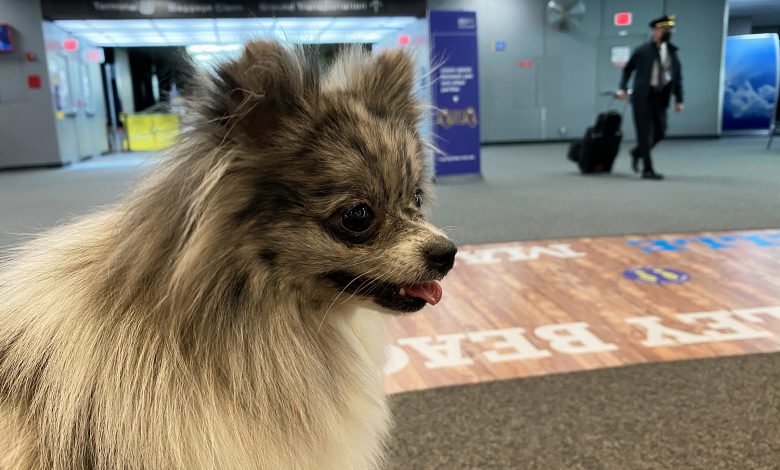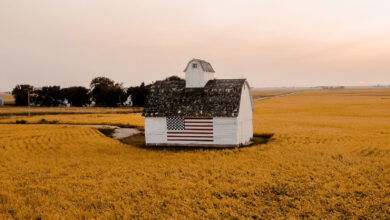
[ad_1]
A major perk of owning a small dog is that you can take them onboard on an aircraft when you fly instead of flying them cargo. Cargo is not only really expensive, it’s also a super stressful and scary experience for dogs. Flying with a dog in cabin in the United States usually costs around $250 round trip – you just need to book them on the flight, make sure you pay the pet fee at the airport and put them in an airline approved pet carrier.
Of course, it’s not quite as simple as that. Dogs can get restless being confined in a carrier and you may have to contend with barking and whining during the flight. You’ll also need to make sure your dog has the correct documentation for the place you’re visiting and you’ll need to pack additional belongings for your pet.
I’ve flown with my pomeranian Luna a few times now so I’ve finally got the airport routine down. Here are my top tips for flying with a small dog:
Before the flight
Determine if your dog has the temperament to fly
Some dogs are fairly calm and rarely make any noise. If you have a dog like this you’re lucky. Other dogs are feisty with lots of energy and can get restless during the flight. Or they simply don’t take well to being enclosed in a carrier.
If you feel like the travel experience will be too stressful for your dog or they’ll make too much noise, you might want to consider hiring a pet sitter on Rover or asking a friend to watch your dog. You’ll need to weigh up the costs too. If you’re going somewhere for a long period of time then it’s likely cheaper to fly with your dog.
However, if it’s just a short trip then you’re probably better off leaving your dog at home. Dogs like their routine and traveling can really disrupt their schedule.
Purchase an airline approved travel carrier
When you get your dog or puppy, you’ll want to buy an airline pet carrier. I’d always recommend buying a soft-sided carrier over a hard carrier because they’re more flexible and can be squished under the seat in front. Airlines have a few strict requirements for pet carriers:
- Must be leak proof
- Must have adequate ventilation, usually on three sides
- Dog must fit comfortably inside the carrier and be able to stand up and turn around
- Must fit under the seat in front
Each airline has its own maximum carrier dimensions for flying with a dog in cabin so you’ll need to check with the airline you’re flying on before you travel. Sometimes the maximum dimensions are determined by the flight and type of aircraft.
Delta’s recommended maximum dimensions is 18” x 11” x 11” although I often find that some of Delta’s planes have barely any room under the seat in front. Even though customer service confirms my bag size is OK over the phone, I find that it’s too big for the space when I get onboard the aircraft. Sometimes I have to squish the bag a bit but I also don’t want to hurt Luna so I just leave it sticking out.
Make sure your dog is up to date with vaccinations
Your dog will need to be vaccinated for rabies and other illnesses, so make sure to check which ones your dog needs in order to fly. Always make sure your dog is up to date on its vaccinations and that you travel with proof of administration.
Visit a vet for the appropriate travel documents
Some airlines will require you to have a pet Health Certificate when you fly with your dog. I fly Delta, which doesn’t require one to travel domestically, but some airlines do. If a certificate is required you’ll need to book a trip to the vet in advance. Also check to see if there’s any other documentation required for the destination you’re traveling to.
Book your dog on the flight
Usually you’ll need to call up the airline and book your dog onto the flight. Airlines have a maximum number of pets they can take in the cabin, so do this well in advance to make sure you can bring your pup with you.
I always call Delta as soon as I’ve booked my ticket, but you could also call them up beforehand to make sure there are spots available. The customer service representative usually asks me for my carrier’s dimensions and also the weight of the carrier with my dog in it. Delta doesn’t take payment over the phone – you have to check your pet in at the airport and pay the pet fee.
Opt for a window seat
If you sit in the aisle then your dog will get disturbed by the food cart and the footsteps of passengers walking up and down the aisle. My dog hates being on the floor in the aisle and gets a bit scared by all the sounds. Book a window seat so you’ll have plenty of privacy and cabin crew are less likely to say anything if your dog is poking its head out of the carrier.
Get your dog used to its travel carrier
About a week or two before your flight you’ll want to start getting your dog used to its pet carrier. Leave the carrier out in your home and throw treats into it now and again. Take your dog outside with you in the carrier and keep the door open, then work towards closing your dog inside. This part is super important, as you don’t want your dog freaking out on the flight.
Consider what dog food you’ll bring
If you feed your dog a particular brand of food then you might want to fly with some in case you can’t get it at your destination.
If you feed your dog dry food then you could easily pack this in your carry on or checked bag. Wet food is a little more complicated. If it’s canned then you could put it in your checked bag, but if your dog food needs to be frozen or refrigerated then it will spoil on the journey. Not to mention it could create a bit of a mess in your bag. If your dog eats fresh food then you’ll probably want to visit a pet store at your destination or pre-order it to the address where you’ll be staying.
I am not a fan of feeding dogs kibble, but there are a number of dog foods that are more healthy and also dry, which is perfect for travel:
Pack the essentials
Make sure you pack your dog’s essentials in your luggage or their pet carrier. This includes a collapsible water bowl, harness, leash, poop bags, travel bowls, ball and a toy. I always pack pee pads too because Luna hates to go potty in the pet relief areas at the airport. They stink!
Give your dog plenty of exercise before the flight
Try to tire your dog out as much as possible before the flight and ensure they burn of any excess energy. Ideally you want them to be so tired that they just sleep in their carrier. Take them for a long walk, play fetch and give them a puzzle toy. My dog tends to get tired after socializing with lots of people, so I often take her to a friend’s house or out in the city with me to ensure she’s as tired as possible.
Consider sedatives as a last resort
Some pet owners visit the vet to get a sedative to keep them calm on the journey. This should only be used really as a last resort. If you do decide to go with the sedative option, make sure you confirm the dosage and administer it before the flight.
Walk your dog before entering the terminal
Once you arrive at the terminal, give your dog a little walk before heading inside. You need to give them as many opportunities to pee and poop as you can before the flight. The last thing you want is your dog needing to go poop before the flight!
Check your pet in
Once you’re inside the terminal you’ll need to check your pet in. Simply go to the check-in desk and tell them you have a pet. They’ll print your boarding pass and give you a tag to put on your pet’s airline carrier. You’ll also pay the pet fee by debit or credit card. If you have a return flight then you’ll need to do the same thing again coming back.
Carry your pup through security
When you get to security, do NOT put your dog through the scanner. You’ll need to take your pup out and carry them through. Usually a member of security staff will bring you aside and have you walk through a separate lane, then swab your hands.
Take them to the pet relief area before boarding
Since I usually allow a couple of hours at the airport to relax, get some food and unwind, I give my dog a little bit of water and a couple of tiny treats. I carry a collapsible water bowl with me and then fill it up at the water fountain.
I then take her to the pet relief area before boarding. You’ll find the pet relief areas throughout the airport, just look out for the signs. A word of warning; they’re gross! They usually have a patch of fake grass and a fake fire hydrant but it just really stinks. My dog is fussy and won’t go on it at all, so I put a pee pad down on the floor instead.
During the flight
Stow the carrier under the seat in front of you
When flying with a dog in cabin, airlines require that you keep your pet inside its airline carrier at all times during the flight. The carrier must also be zipped shut and stowed under the seat in front of you. In reality, most cabin crew members request that the carrier remain under the seat in front during take-off and landing, but they’ll often allow you to put it on your lap during the flight.
Put the carrier on your lap during the flight
Once the plan has taken off and you’re up in the air, you can usually put the carrier on your lap. My dog doesn’t like being on the floor simply because it’s dark down there and she wants to be able to see. Obviously if a member of cabin crew comes along and tells you it’s not OK, then do as they say and put the carrier back down. Otherwise, keep it on your lap during the flight so your pet feels close to you.
If your dog is whining, try putting a hand inside the carrier
If your dog is whining or barking you could try unzipping the carrier slightly and putting your hand inside. Gently pet your dog and comfort them, or even feed them small treats.
If your dog is sleeping and quiet, don’t disturb
If however your dog is relaxed and sleeping, leave them to it. Leave the bag on the floor and don’t disturb them. As the saying goes; “let sleeping dogs lie”.
Try giving your dog a chew toy to relax
Flying can be a stressful experience for a dog because they have no idea what’s going on. Try giving them a chew toy to soothe them and keep them occupied during the flight.
On long-haul flights, take your dog to the bathroom to pee
When I fly I take pee pads with me. If your dog is pee pad trained you could take the carrier to the onboard bathroom, unzip the carrier and put a pee pad on the floor so they can relieve themselves. On short flights your dog can probably hold it but on long flights they may need to pee. In case you can’t take the dog to the bathroom, line the carrier with a pee pad or a blanket so you can easily take it out if they soil themselves.
After the flight
Give your dog water
As soon as you get off the plane, take them to the nearest bathroom and then give them some water. Your dog will likely be feeling very thirsty and dehydrated from that dry, cabin air.
Go purchase dog food
When you’ve arrived at your destination, go straight to purchase dog food if you need it. Research nearby pet stores and their opening hours so you know exactly where you’re going. If your dog is picky and you want to stick to a specific brand of dog food, it’s worth calling the store and checking they have it before you go.
Let your dog adjust
It will take your dog some time to adjust to its new environment. My dog usually refuses to eat for the first few days when she’s in an unfamiliar place. If your dog does this, don’t worry! If your dog won’t eat, just try again at the next meal. Feed your dog its favorite treats and give it time to feel more comfortable.
Don’t leave your dog alone straight away
At some point you’ll probably need to go out for a couple of hours and leave your dog in the new place where you’re staying. Let them get acclimatized to their new space and don’t leave them alone on the first day otherwise they’ll probably get anxious. Take them out with you to explore and get a feel for the neighborhood.
A final word about flying with a dog in cabin…
Flying with a small dog requires some extra planning and can be a bit stressful, especially if it’s your first time. Just like flying with babies, there are extra things you need to pack and sometimes they just don’t cooperate. Make sure you prepare in the run up to your trip and give yourself plenty of time at the airport so you can make sure you’re not rushing around too much.
[ad_2]
Source link






